Motorola Droid 3 Review - Third Time's a Charm
by Brian Klug on July 30, 2011 12:01 AM ESTBattery Life
Of course the next question is how battery life fares, after all, it doesn’t matter too much in a mobile device if we have great application performance but need to be tethered to a charger all day long. Back to those Cortex-A9s, the next part of the picture is what power management features are and aren’t supported. First off, OMAP4 is a synchronous architecture, which means that there’s one frequency plane for both A9s - each runs at the same clock. Both can be clock gated, however.
The important next bit is that each CPU is on its own power domain. The power states of each CPU doesn’t have to be the same, and OMAP4 supports three modes - Normal (run), dormant, and power off. You can see the different power domains as illustrated by the following diagram.
TI also provides a nice table with the supported power states and clock gating states depending on what assertions are made in the local power control module register.
What’s particularly interesting is that we can actually watch cores turn on and off both through console output on the device (by running something like dmesg) and moreover there’s even some nice software that will show us graphically. System Panel (which I’m a pretty big fan of) recently added support for visualizing load on multicore Android devices, and you can see how things fare when there’s both idle activity (CPU1 gets shut completely off), and when I’m generating tons of load by flicking the page around wildly (both CPUs are on, and clocked at 1.0 GHz).
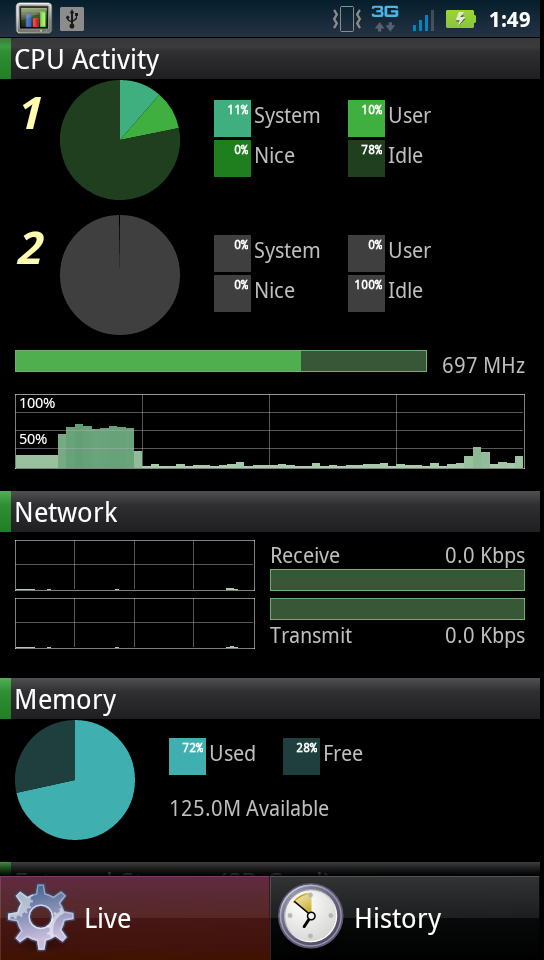
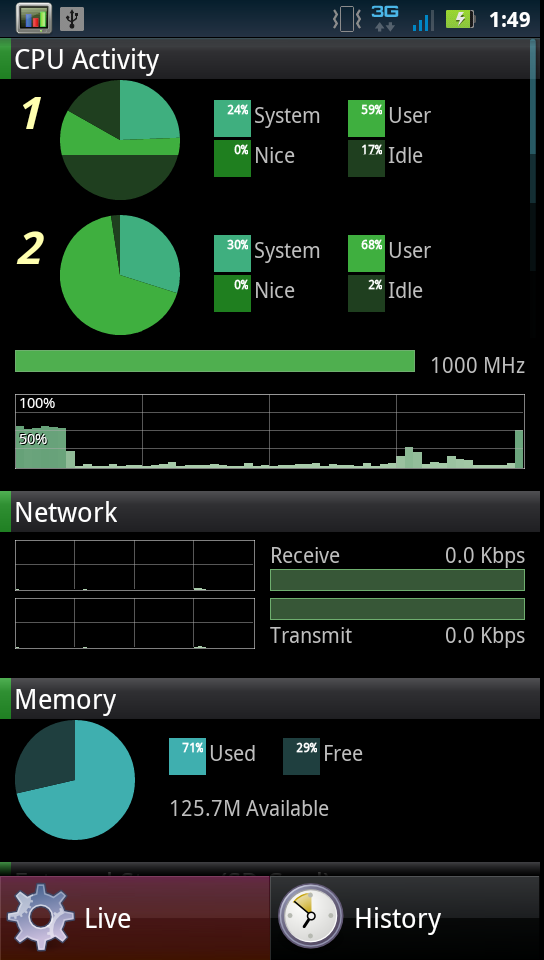
Like most modern SoCs, OMAP4 can dynamically change frequency, however it also can dynamically change voltage with a power management technique called SmartReflex. There are two different modes for SmartReflex, one which consists of an entirely hardware-controlled voltage control loop (class 3) and another which is assisted using software control (class 2). I’ve verified that the Droid 3 is using class 3:
“<6>[ 0.000000] SmartReflex CLASS3 initialized”
SmartReflex encompasses both the dynamic frequency, voltage, and power switching functions on the OMAP4430. The aim is to use silicon in the best way possible depending on either static silicon performance (given manufacturing) or dynamically based on temperature induced performance, and raise or lower voltage accordingly. To a large extent, SmartReflex it somewhat analogous to Intel’s SpeedStep and related suite, and in OMAP5 even gains a turbo mode which allows the SoC to temporarily exceed its normal maximum clock.
Now that we’ve gone over the power features of OMAP4, it’s time to present some Droid 3 specific battery life results. As usual, we’ve run our battery life testing suite on the device. The first set of tests are our page loading suite, which load through a few dozen pages every 10 seconds or so until the phone dies. The backlight brightness is at 200 nits and of course always on, to mimic continual web browsing.
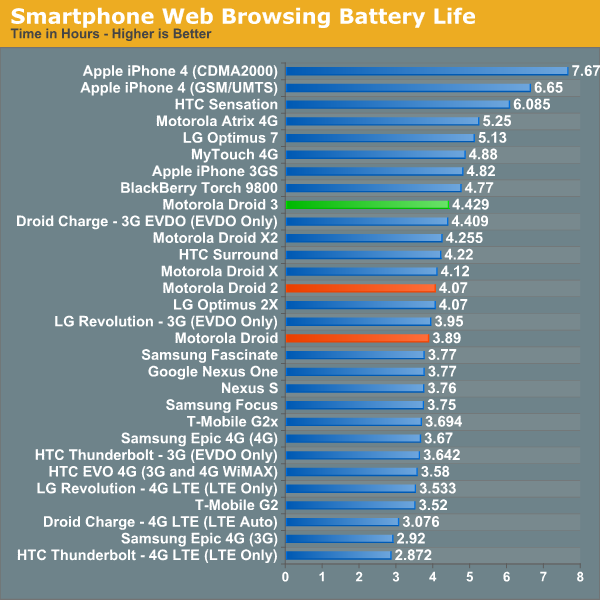
The Droid 3 both brings improvements in performance and display resolution alongside better battery life for smartphone web browsing. The other interesting performer to keep eye on is the Droid X2, which includes the same sized battery and baseband (MDM6600), but Tegra 2.
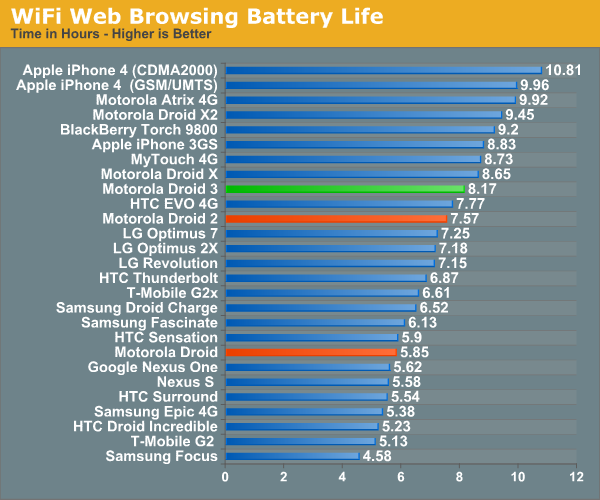
Next up is WiFi web browsing, where we run the same test but using WLAN instead of cellular connectivity. Here we can’t compare to the Droid X2 anymore as there are different WLAN stacks in each, but the Droid 3 continues to outperform its predecessors.

Motorola continues to somehow have a secret sauce for continually delivering incredibly long call time battery life, with now five spots dominated by Motorola devices. I’m still at a loss for exactly what they’re doing that gives them such a leg up, but it’s considerable.
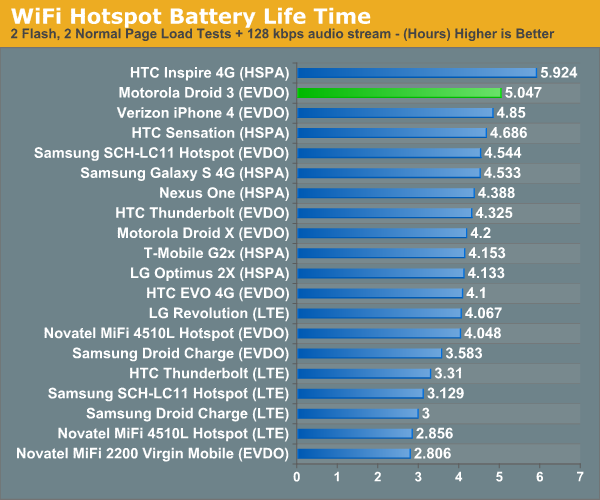
Finally is the WiFi hotspot battery test, which consists of a single WLAN client loading four tabs of our page loading test (two with flash content, two without), and a 128 Kbps MP3 streaming internet radio station. The display on the device is off the whole time. It’s a heavy test that mimics continual use and keeps everything awake on the device.
Here the Droid 3 does very well, though we don’t have any comparison data from the Droid 2 or Droid 1 due to this being a newer test. The overall results definitely illustrate the potential power savings of a dual core architecture - to put it in Anand’s words, you just can’t beat voltage scaling when dealing with power.


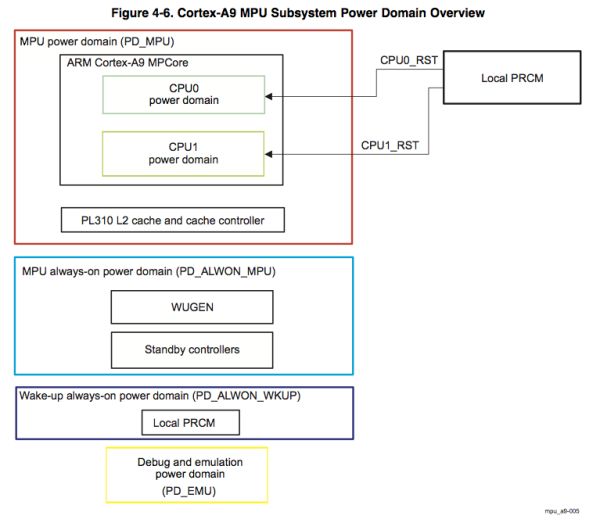
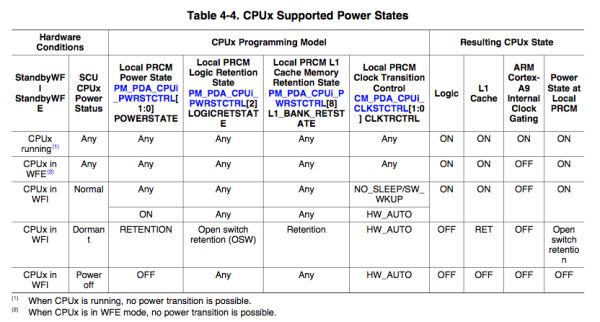








84 Comments
View All Comments
Myrandex - Monday, August 1, 2011 - link
5th row keyboard looks very nice. I did compare one in the store to my Touch Pro 2, and unfortunately I still have to side with the touch pro 2. I tried typing out a sentence and the button size of the touch pro 2 just seemed to reign supreme. It is in the right direction though!Jason Cook
Johnmcl7 - Monday, August 1, 2011 - link
That sounds promising, if they're going to make a Chinese version they may produce an EU version as well given they're producing the hardware anyway.John
aggiechase37 - Tuesday, August 2, 2011 - link
I have the D3. Couple things:1. Gingerbread keyboard does NOT come preinstalled, nor does Angry Birds.
2. I have issues with lag coming back to the homescreen. This is especially persistent with the camera app
3. I also have issues with framerate drops swiping through homescreens and the app drawer. Minor, but noticeable. Hardly as fluid as Anandtech boasts.
4. Something should be said about the screen being much more view-able in direct sunlight, moreso than any screen I've seen so far.
5. Camera lowlight conditions are considerably improved over D3's predecessors.
6. There are issues with the led flash causing a blue tint when snapping pics with NO light, like utter darkness. But seriously who does that?
7. 3rd party launchers are not compatible with Moto's widgets.
8. Moto's launcher eats 40mb's of RAM, seems a little excessive.
9. Task killer included on the phone. Is Moto insane???
relativityboy - Thursday, August 4, 2011 - link
I ordered one of these the day they came available. Coming from a rooted, very customized CM7 D1 I was a little underwhelmed. While there's no question the D3 is capable of more at the limit my D1* felt good in the hand. I don't care for the hard edges of the D3.
* had excellent performance (I lucked out - low voltage ChevyNo1 kernel @ 1.1Ghz). With swap and a fast SD chip I didn't have the launcher reloading all the time.
* had very good battery life (1.5-2 days of med/lite use)
* felt much smaller in the pocket
* actually had better performance in tasks like scrolling the contacts list, and rendering pages in opera/stock browsers
* The radios on the D1 have better reception. I'm not talking about bars on a screen or stats in a test bench. In my office people often complain about dropped calls, poor wifi in the bathrooms(yep), etc. I had no idea what they were talking about until I switched to the D3.
* the touch screen seems less sensitive that on my D1.
--
I'm sure some of my complaints are related to immature software, but things like radio reception shouldn't be related to that. I've had a number of kernel panics, and display resets.
Maybe I got a bad phone, but I'm not sold on the D3.
relativityboy - Friday, August 5, 2011 - link
Today I'm completely frustrated with this piece of bunk. Seriously. This phone is crashing, getting worse, can't get a GPS lock to save it's life.On the bright side, with the kinds of problems I'm having it might not all be buggy software.
amankumar - Thursday, August 4, 2011 - link
want some super cool android HD games to unleash its potential, here's the link:http://nitin-xyz.blogspot.com/2011/07/free-and-ful...
Death666Angel - Thursday, August 4, 2011 - link
Hey! I just wanted to comment on the last paragraph of this review. I personally had a Touch Pro 2, bought it in August 2009. It has a pretty good keyboard, when the reviewers are to be believed. And although the touchscreen was resistive and thus not as easy to navigate as modern capacitive touchscreens, I hardly ever used the keyboard. Unless you type unusually long emails or are in the business of typing up reports on your smartphone, the tradeoff you have to make for a keyboard smartphone isn't worth it in my opinion.My Galaxy S2 is hardly bigger (125mmx65mmx8mm) than the Droid3 and significantly lighter (117g). I probably wouldn't win a typing contest when we had to type a whole page. But SMS, comments, short email reply I'd win.
The only thing the keyboard on my TP2 was useful for was as a gamepad for my Mega Drive emulator. I played through Soleil on it. But I have already played through Legend of Zelda and am 80% through Secret of Mana on my SNES emulator on the Galaxy S2 using the overlayer gamepad. With some USB-host gamepad support it will be even better.
So, to summarize, I would never buy a keyboard smartphone again because the cons outweigh the pros for me. (Only the Playstation phone looked interesting....)
EEWdad - Sunday, August 7, 2011 - link
It is very refreshing to see a comprehensive and unbiased review of this update to the Droid 2. Many other reviews I've seen on web have largely dismissed the Droid 3 as a worthy product -- mostly due to the absence of 4G/LTE.It was nice to see AnandTech's combination of device performance metrics and hand-on impressions to used to objectively assess the capabilities of the Droid 3 -- much different outcome from the other reviewer's rather subjective opinions. From what I can see from this review, I think the hardware performance, 3-D interface, keyboard, web browsing, wi-fi, video, photos, phone voice quality and noise-canceling capabilties are pretty darn impressive.
My wife has had a Droid 2 for about a year now -- I think it's been a reasonably good smartphone. Since getting hers, I've been wanting one for myself; after reading this review, my confidence is high -- I've taken the plunge and ordered a Droid 3 for myself.
Please, keep up the good work!
2therock - Tuesday, August 9, 2011 - link
Cannot Wait For You To Get A BionicZaniyah - Friday, August 19, 2011 - link
I just love my Droid 3 and the navigation system on it works fantastic. The pictures are excellent. It took me a while to get use to it, but there were so many positives that outweighed the negatives. It is worth every dime I paid for it. Honestly, I love everything about my Droid 3.